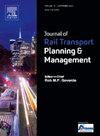System analysis of train operations to improve freight flow on high gradient rail bottleneck section with mixed traffic
IF 2.7
Q3 TRANSPORTATION
Journal of Rail Transport Planning & Management
Pub Date : 2025-06-04
DOI:10.1016/j.jrtpm.2025.100522
引用次数: 0
Abstract
This paper analyzes the operations of freight trains on high-gradient rail sections, which are common on India’s western and eastern coasts (known as a ghat section). Operations in these sections differ from regular rail operations. Resource usage differs for passenger trains and freight trains and depends on whether the train is ascending or descending the graded section. This creates an imbalance in resource usage and adds complexity to these operations. Priority for passenger trains adds to this complication, making freight train scheduling challenging. This study analyzes different techniques to improve the freight throughput of the graded sections, considering the case study of the Lonavala-Karjat section. Freight trains on this section experience extended delays, leading to a network capacity bottleneck. Identifying the root cause of these delays is not straightforward, as operations are interrelated. Therefore, the study employs a systems thinking approach, beginning with identifying bottleneck resources. A discrete event simulation model is employed due to its ability to replicate complex real-world scenarios and assess the impact of different variables on system performance. Based on the findings, policies are proposed to optimize freight flow on the graded rail section.
混合交通高梯度轨道瓶颈段列车运行改善货流的系统分析
本文分析了货运列车在高坡度铁路路段的运行情况,这在印度西部和东部海岸(被称为ghat段)很常见。这些路段的运营不同于普通铁路运营。旅客列车和货运列车的资源使用情况不同,这取决于列车是上升还是下降。这造成了资源使用的不平衡,并增加了这些操作的复杂性。客运列车的优先级增加了这种复杂性,使货运列车调度具有挑战性。本研究以Lonavala-Karjat路段为例,分析不同的改善分级路段货物吞吐量的方法。这一路段的货运列车延误时间延长,导致网络容量瓶颈。确定这些延迟的根本原因并不简单,因为操作是相互关联的。因此,本研究采用系统思维方法,从识别瓶颈资源入手。采用离散事件仿真模型是因为它能够复制复杂的现实世界场景并评估不同变量对系统性能的影响。在此基础上,提出了分级段货流优化政策。
本文章由计算机程序翻译,如有差异,请以英文原文为准。
求助全文
约1分钟内获得全文
求助全文
来源期刊

Journal of Rail Transport Planning & Management
TRANSPORTATION-
CiteScore
7.10
自引率
8.10%
发文量
41
 求助内容:
求助内容: 应助结果提醒方式:
应助结果提醒方式:


